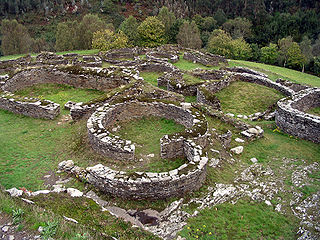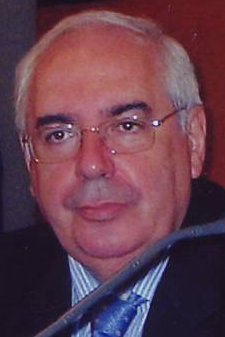
Asturias, officially the Principality of Asturias, is an autonomous community in northwest Spain.

Gijón or Xixón is a city and municipality in north-western Spain. It is the largest city and municipality by population in the autonomous community of Asturias. It is located on the coast of the Cantabrian Sea in the Bay of Biscay, in the central-northern part of Asturias; it is approximately 24 km (15 mi) north-east of Oviedo, the capital of Asturias, and 26 km (16 mi) from Avilés. With a population of 273,744 as of 2023, Gijón is the 15th largest city in Spain.

Eo-Navia is one of eight comarca administrative divisions of Asturias, a province and an autonomous community in Spain. Within the area, Eonavian, a Galician dialect, is spoken. This administrative division should not be confused with the historical comarca of Eo-Navia or Old Common Council of Castropol.

Boal is a municipality, a civil parish and a town in the Autonomous Community of the Principality of Asturias (Spain). It borders north with El Franco and Coaña, south with Illano, west with Castropol and east with Villayón.

Castropol is a municipality in Asturias, Spain. It is also the name of a parish within the municipality and a town within the parish.

Allande is a municipality in the Autonomous Community of the Principality of Asturias, Spain. Its capital is Pola de Allande.

San Martín de Oscos is a municipality in the Autonomous Community of the Principality of Asturias. It is bordered on the north by Illano, on the south by Grandas de Salime, on the east by Pesoz and on the west by Santa Eulalia de Oscos and Villanueva de Oscos.

Peñamellera Baja is a municipality in the Autonomous Community of the Principality of Asturias, Spain. It is borderered to the north by Llanes and Ribadedeva, to the west by Peñamellera Alta, and to the east and south by the Autonomous Community of Cantabria.

Cuaña is a municipality in the Autonomous Community of the Principality of Asturias, Spain. It lies along the Cantabrian Sea to the north, and is bordered on the south by Boal, on the east by Navia and Villayón across the Navia River, and on the west by El Franco.

El Franco is a municipality in the autonomous community of the Principality of Asturias. It is bordered on the north by the Cantabrian Sea, to the west by Tapia, to the south by Castropol and Boal, and to the east by Cuaña. El Franco is part of the comarca of Eo-Navia.

Lugones is a parish in Siero, a municipality within the province and autonomous community of Asturias, in northern Spain.
Serantes is one of four parishes in Tapia de Casariego, a municipality within the province and autonomous community of Asturias, in northern Spain.
Campos y Salave is one of four parishes in Tapia de Casariego, a municipality within the province and autonomous community of Asturias, in northern Spain.

The 1991 Asturian regional election was held on Sunday, 26 May 1991, to elect the 3rd General Junta of the Principality of Asturias. All 45 seats in the General Junta were up for election. The election was held simultaneously with regional elections in twelve other autonomous communities and local elections all throughout Spain.

The 1995 Asturian regional election was held on Sunday, 28 May 1995, to elect the 4th General Junta of the Principality of Asturias. All 45 seats in the General Junta were up for election. The election was held simultaneously with regional elections in twelve other autonomous communities and local elections all throughout Spain.

The 1999 Asturian regional election was held on Sunday, 13 June 1999, to elect the 5th General Junta of the Principality of Asturias. All 45 seats in the General Junta were up for election. The election was held simultaneously with regional elections in twelve other autonomous communities and local elections all throughout Spain, as well as the 1999 European Parliament election.

The 2003 Asturian regional election was held on Sunday, 25 May 2003, to elect the 6th General Junta of the Principality of Asturias. All 45 seats in the General Junta were up for election. The election was held simultaneously with regional elections in twelve other autonomous communities and local elections all throughout Spain.

The 2007 Asturian regional election was held on Sunday, 27 May 2007, to elect the 7th General Junta of the Principality of Asturias. All 45 seats in the General Junta were up for election. The election was held simultaneously with regional elections in twelve other autonomous communities and local elections all throughout Spain.

Jesús Evaristo Díaz-Casariego y Fernández-Noriega was a Spanish writer and publisher, popular especially during the early and mid-Francoism. Among some 60 books and booklets he wrote most are popular and semi-scientific historiographic works, though he was known chiefly as a novelist, especially as the author of Con la vida hicieron fuego (1953). In the early 1940s he managed a vehemently militant Francoist daily El Alcazár, yet in his youth and older age he was active as a Carlist. Today he is considered the author of second-rate literature, occasionally recognized as expert on Asturian culture and history.

The next Asturian regional election will be held no later than Sunday, 28 May 2023, to elect the 13th General Junta of the Principality of Asturias. All 45 seats in the General Junta will be up for election.





















